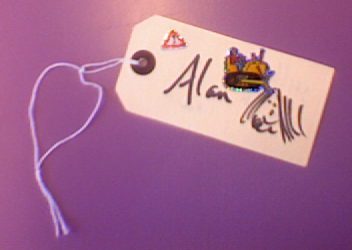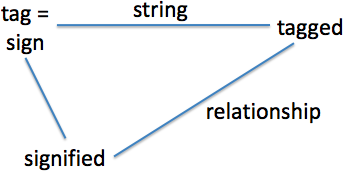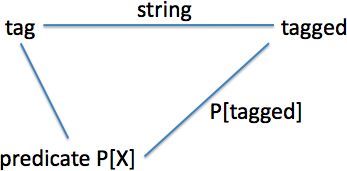I’ve just been at a two-day workshop on “Tags and Tagging” organised by the “Branded Meeting Places” project.
Tags are of course becoming ubiquitous in the digital world: Flickr photos, del.icio.us bookmarks; at the digital/physical boundary: RFID and barcodes; and in the physical world: supermarket price stickers, luggage labels and images of Paddington Bear or wartime evacuees each with a brown paper label round their necks. Indeed we started off the day being given just such brown paper tags to design labels for ourselves.

As well as being labels so we know each other, they were also used as digital identifiers using a mobile-phone-based image-recognition system, which has been used in a number of projects by the project team at Edinburgh (see some student projects here). We could photograph each others tags with our own phones, MMS the picture to a special phone number, then a few moments later an SMS message would arrive with the other person’s profile.
Being focused on a single topic and even single word ‘tag’ soon everything begins to be seen through the lens of “tagging”, so that when we left the building and saw a traffic warden at work outside the building, instantly the thought came “tagging the car”!
 The workshop covered loads of ground and included the design and then construction of a real application – part of the project’s methodology of research through design. However, two things that I want to write about. The first is the way the workshop made me think about the ontology or maybe semiology of tags and tagging, and the second is a particular tag (or maybe label, notice?) … on a toilet door … yes the good old British scatological obsession.
The workshop covered loads of ground and included the design and then construction of a real application – part of the project’s methodology of research through design. However, two things that I want to write about. The first is the way the workshop made me think about the ontology or maybe semiology of tags and tagging, and the second is a particular tag (or maybe label, notice?) … on a toilet door … yes the good old British scatological obsession.
String and The Semiology of Tags
We filled sheets full of key terms with arrows and lines between them, but for me one of the key concepts was the string that ties a paper tag to whatever is being tagged. Of course the string is itself simply an emblem: for a price sticker it is the glue and for a Graffiti artist it is the act of painting. However, the crucial thing about the string (or sticky, or whatever), is that it joins tag to tagged.
Because the string joins the tag to the tagged it emphasises the ancillary role of the tag. The tag s not part of the tagged thing, but a add-on, an annotation, or in a Semantic Web world, meta-data.
The tag itself is usually in some way conveying information – in classic semiotics it is a sign. In the case of iconic or textual tags (for example, a price tag) a sign to be directly interpreted by the observer, in the case of digital tags (such as a barcode, or RFID tag) an identifier that is associated with further information, or sometimes both, as was the case with the application that recognised our hand crafted name tags.
The act of sticking or tying a tag onto a physical object, or digitally tagging a photo in Flickr, at one level binds the tag to the tagged object. However, the binding of tag to tagged is not just an association between them, otherwise every knot tying would be a tagging. The crucial thing is that by tying the tag to the tagged an implicit relationship is created between the tagged and thing or concept signified by the tag. In the case of a tied-on tag, the string is the physical representation of the relationship.

The thing signified by the tag and the relationship signified by the string may be of many kinds:
In the case of a tag on a cow’s ear or a brand on a slave the thing signified is a person and the relationship is ownership.
- In the case of a price label, the thing denoted is the money and the relationship cost.
- For tagged images in Flickr, the signified thing is some sort of concept or category and the relationship establishes that thing is (or is believed to be) of the signified category.
- For the evacuee children or destination labels on luggage, the signified is place and the relationship “is going to”.
In some case it may be better to think of the thing signified as a predicate or property and the relationship imputed by the string (or sticking) as ‘satisfies the predicate’. The security stickers on luggage or the frank on a letter does this saying “this luggage has been checked” or “this letter has been sorted”.

Graffiti tags are particularly interesting as the message behind a tag on a bridge or wall is not so much a statement about the wall itself, but says “the tagger was brave (or foolish) enough to climb to this dangerous position, or risk arrest by the police to do this”. Here the tagged thing itself is a sign that represent the danger, illegality and risk associated with the place and the subject of the tag becomes the tagger herself.
There was and is far more to write about this … but as this is already becoming an essay rather than a blog, I will move on. My fascination with the string is perhaps because it is embodying relationship and so picks up on themes of externalisation allowing higher-order thinking …
A Note on the Toilet Door: Performative Labelling
While with a head full of tags and also thinking signage, I noticed that the toilet downstairs from the meeting room had a paper sign on. Presumably there had once been a metal sign, similar to (but different from) that on the women’s toilet opposite, but this had, I guess, fallen off and lost and hence the stuck-on paper sign.
[[image of sign to come]]
This made me ponder on the nature of the sign. For me it was more like a signpost, telling me where to go, or maybe a sort of warning “what lies behind this door is a men’s toilet”.
If there had been no sign, the nature of the room would have been immediately obvious, as you opened the door a line of urinals faced you. The room is a men’s toilet because that is what it is and the sign on the door is merely descriptive, telling you what is true anyway.
[ image to come]]
However, in InfoLab21 where I work, the ladies and gents toilets are identical, the only distinguishing feature is the sign on the door. I was reminded of Searle/Austin’s speech act theory and perfornative utterances, such as the minister at the wedding “I now pronounce you man and wife”. It is the speaking of the words that makes them true. In the case of the InfoLab21 toilets, the sign on the door is a performative tag/label – the toilet is a men’s toilet because the sign says so.
Ownership tags, or a dog peeing on a lamppost are similar … which I guess is an appropriately scatological point to stop.